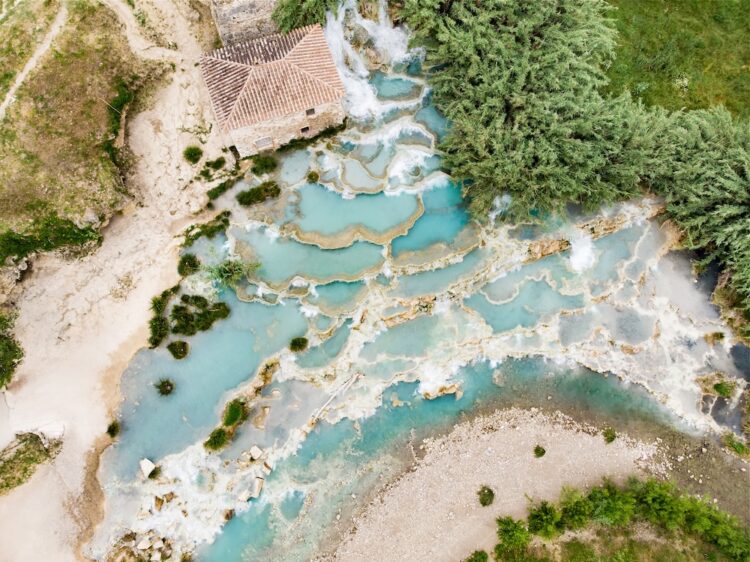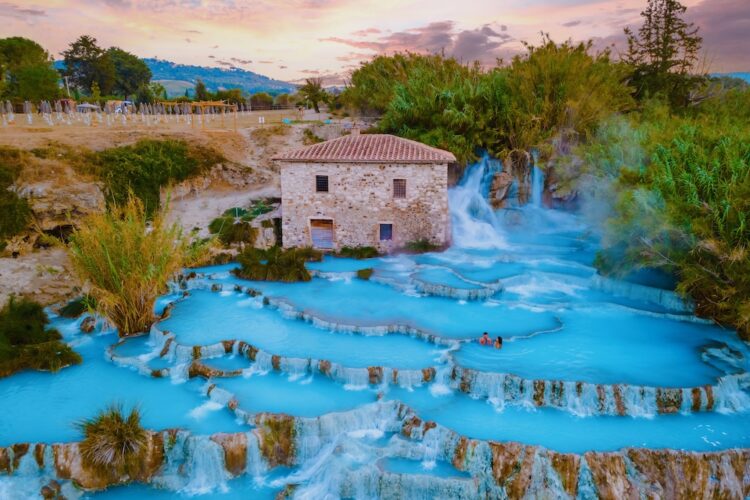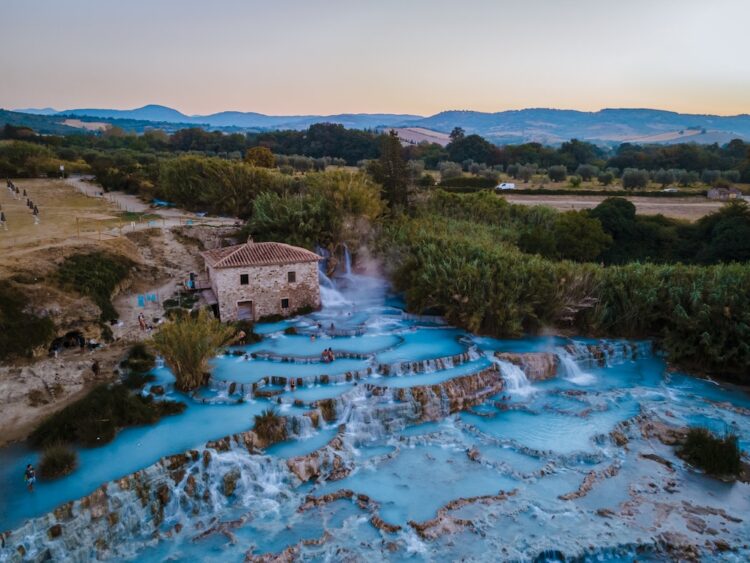Saturnia Hot Springs is a natural hot spring in the heart of Tuscany, Italy. Known for its therapeutic properties, the springs are steeped in history and geological significance. An easy day trip from Rome or Florence, Saturnia is open and free to the public. The waters here originate from deep within the earth’s crust, heated by geothermal energy. As the water makes its way to the surface, it absorbs minerals and sulfur compounds, which many believe to have healing properties. This geothermal journey results in the water’s unique composition and warmth.
Like other regions with natural hot springs, the earth’s crust is thinner in Saturnia, allowing geothermal heat to warm the water to a soothing temperature of around 98-100 degrees Fahrenheit. The water temperature is consistent throughout the year, making the springs an all-season attraction, including winter.
One of the most striking features of Saturnia is the turquoise color of the water, the result of the mineral-rich content, particularly the sulfur, which gives the water its therapeutic qualities. The warm temperature, combined with the mineral composition, provides a uniquely relaxing and healing experience, giving visitors seeking both relaxation and natural remedies for various ailments more than enough reason to go. However, the natural beauty of the mineral-laden springs attracts those who admire the naturally photogenic quality of the varied stone pools of water where the bathers sit and relax.
As you may suspect, there is a mythological story attached to the springs. The name ‘Saturnia’ has roots in a Roman legend that recounts how the god Saturn, angered by the constant wars of humans, sent a thunderbolt to Earth, creating a magical spring of warm, sulfurous water to pacify mankind. Over the centuries, the Saturnia Hot Springs have been a constant presence in the region’s history. The Etruscans and Romans, known for their baths, utilized these springs, and remnants of ancient Roman baths can still be seen near the site.

The myth contributes to the otherworldly allure of the springs, making them not just a natural attraction but also a place of historical and cultural significance.
The sight of steam rising gently from the turquoise pools set against the backdrop of the lush Tuscan landscape is worth the trip anytime of year. The springs comprise several natural pools and waterfalls, with the most famous being the Cascate del Mulino, a picturesque series of cascading pools nature has sculpted out of the rock. Visitors can walk along the paths surrounding the springs, take a dip in the warm, mineral-rich waters, and relax in the natural terraces carved by the flowing water over millennia.
When planning a visit to Saturnia, it’s advisable to bring swimwear, towels, and water shoes to navigate the rocky terrain and rough bottoms of the stone pools comfortably. The rock at the bottom of the pools is rough, so water shoes of some type are a necessity. Since the waters contain high sulfur content, it’s also recommended to not to bring silver jewelry or delicate fabrics.
Reaching Saturnia from major Italian cities like Rome or Florence is relatively straightforward. From Rome, it’s about a two-and-a-half-hour drive, and from Florence, the journey takes approximately three hours. The scenic drive through the Tuscan countryside is an added attraction. Public transport options are limited, so renting a car is the most convenient way to reach the springs.

Saturnia Hot Springs is equipped with facilities. There is a restaurant and a small shop on site and many people picnic while visiting in good weather. There are co-ed restroom facilities and a changing area, but there are no lockers, so most people leave their valuables locked in their car since most drive to Saturnia.
Besides the natural pools, there are well-developed spa resorts nearby, offering a range of services from luxurious spa treatments to accommodations. For those looking for a more rustic experience, there are also local bed and breakfasts and small hotels in the nearby town of Saturnia. The town itself offers charming restaurants, cafes, and shops, allowing visitors to explore local Tuscan cuisine and culture.


